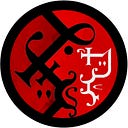Cocytus — Intro

Cocytus, the westernmost principality of the Holy Infernal Empire, is the only place where you can have nostalgia for the future and trepidation for the past.
Cocytus projects itself into the ocean and its promises while neglecting the mainland, be it the immediate surroundings or the whole continent. The principality has been described either as “the fierce bow of the Empire, cleaving the waves on the unknown” or as “the Imperial Panther’s lazy tail, weighting down its every pounce.” Both statements are often correct.
The Undine Ocean is teeming with sea life, and the cocytian economy revolves around fishing and exploiting that marine resources. Cod and whales are the main catches, but a lot of effort goes into the hunt for Leviathans and Krakens, gigantic creatures that give their captors prized commodities and heroic glory.
Cocytus has always been at the forefront of ship-making technology, navigation tools, weaponry, and food processing. From Zagan, the capital city, many explorers have sailed, looking for bountiful seas, islands to colonize, and uncharted routes.
Sometimes ships venture on the high seas to find what’s on the other side of the ocean, never to return, at least not with an answer. The few crew that made their way back to the shore tell stories about a Second Horizon, a line of gleaming blue light that devours everything attempting to cross it. These tales energize more explorers than they dissuade: all are sure to be braver and cleverer than their predecessors.
The retellings of daring adventures convince just some, but the rare oddities wash on the beaches persuade many others.
During the years, three-eyed skulls, indigo driftwood, corpses of seagulls with shark heads, and shards of glowing glass ended up on the shore of Cocytus, all pointing to a land and a civilization beyond the Second Horizon. Even if a transoceanic journey scares you, the prospect of exotic and unknown riches may push you to set sail.
The perils of the seas and the challenges of the unknown have primed Cocytus for Divination Magic. Everyone, high up or lowbrow, wants to know what the waters have in store for them: from the noble anxious for the result of the whaling season to the fisherman wife worrying about the fate of her husband.
To the varied clientele correspond a varied offer with venerable wizards, humble druids, and conning soothsayers all selling predictions to whom can afford them.
Divination magic is the most unreliable of all kinds of magic: one can get glimpses of likely future outcomes without certainty. And there’s always the catch: trying to avoid what is coming, am I making it more probable? Despite that, Cocytians are very confident in the diviners’ accuracy. They will do various good luck rites to sway the course of fate, giving them the reputation of being superstitious and deluded.
Since all this attention is given to the sea, the land is neglected and almost forgotten. The land itself doesn’t do much to be appealing, being made mainly of rocky mountains and stony hills that are hard to work and scarce in yield. Woods and pastures are much more convenient land use, so the center and south of Cocytus are left unkept, with barebone farming. The aristocrats don’t care: they are all crammed in the Capital and the west coast cities, leaving the administration of their territories to resentful cadet branches and unmotivated administrators.
The inland has corners that have never been explored or even explored extensively. Southern Cocytus is one of the few places where you can find ruins from the ancestral times of this world, before the Cosmic War and the Collapse.
There are many suggestive sights in inner Cocytus: among the field of wild lavender, solitary columns and walls of lost cities; in the woods, the trees enveloped statues and foundations; in the mountains, crumbling villages still host tunnels and catacombs.
These ruins excite the adventurers with the prospect of discoveries, be they treasures, artifacts, or secrets. Some have been found in the past, sure, but mostly turned out disappointing. The Sacred Texts that detail the history of the world are mostly correct, and archeological findings seldom bear any new information. And also, it turns out the Golden Age has not had much real gold to offer after all.
Not all explorers are discouraged: there are many other ruins deep in the woods and high on the mountains where few men ventured. Many stories and rumors say so, and Diviners of all sorts confirm (and those fortune tellers will also sell the maps they see through their clairvoyance, guaranteed to lead to unseen sites).
While it’s probable there are still places and relics to discover, they have not been discovered for a couple of reasons. The inland is a refuge for many criminals and bandits, able to be ignored in the wilds.
Some demon tribe supposedly still lives on the sides of the Aghation Peaks, probably insane from a millennium of inbreeding and demented rituals.
But the biggest problem to a traveler is the gigantic birds living at the top of mount Sunsummit, the larger species of which is the Oceanic Roc, a gargantuan seagull with a wingspan wide as a palace. These gigantic seagulls can easily nest in the middle of the land while still feeding on high seas, being able to travel leagues with just a flap of their immense wings. They usually eat Leviathan and Kraken, small like mackerels or squids to them, but they will feed on anything that moves out of boredom or if they feel peckish.
An explorer may start her journey in Cocytus thrilled and hopeful to find some precious piece of the past, something so old it’s new. But there is a good chance she will end it remembering fondly the future she had ahead before it became a grim present in the mouth of a giant bird.
